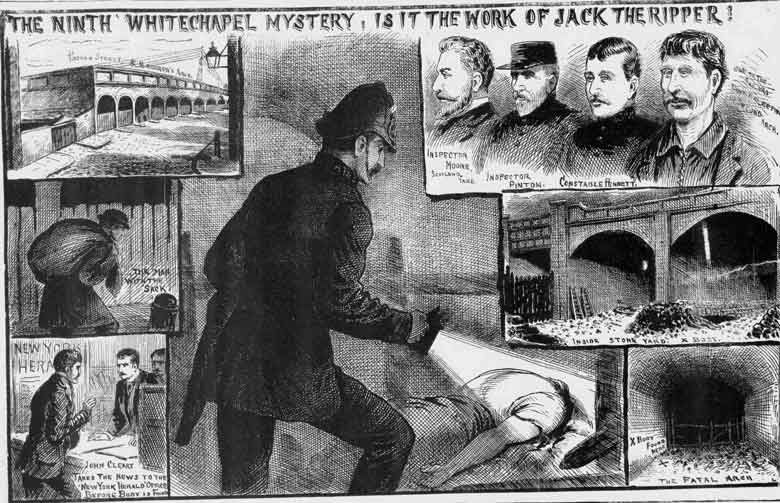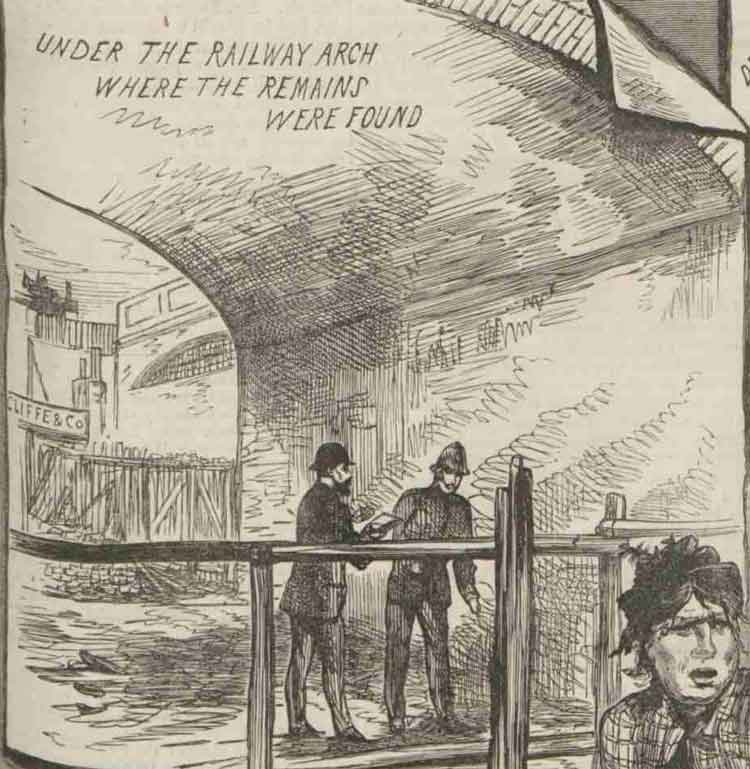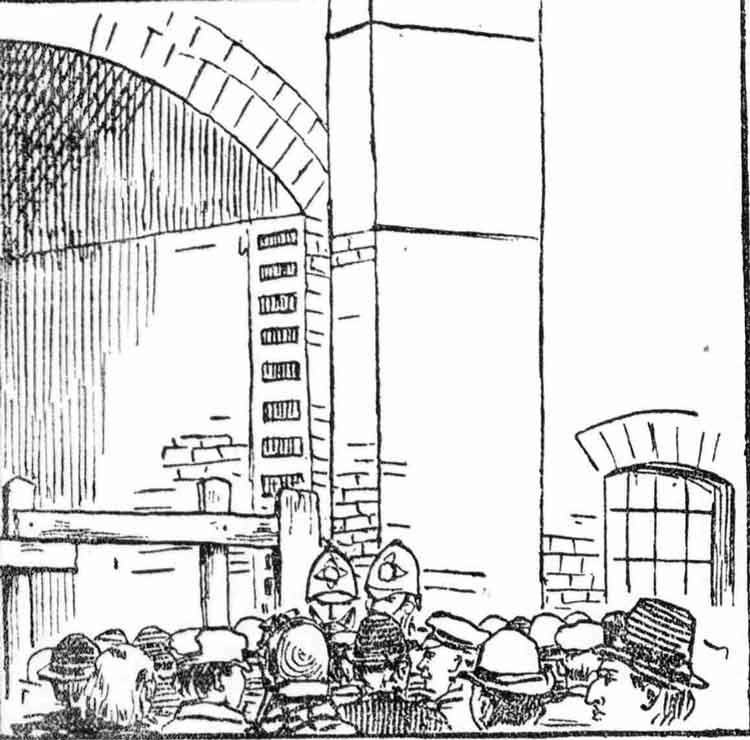On the 10th of September 1889, Police Constable Pennett found the torso of a woman – which was missing the head and legs,and which was covered over by part of an old chemise – under a railway arch in Pinchin Street in the East End of London.
Inevitably, the grisly discovery led to speculation that Jack the Ripper had returned, and the press duly began reporting on the murder, albeit without, apparently, managing to create the nervous apprehension that they had succeeded in creating in the area during the autumn of 1888.
It was as though the people of Whitechapel and Spitalfields had become immune to the horror of an unknown murderer still prowling their streets by night.

THE PALL MALL GAZETTE
In its issue of Wednesday September the 11th, 1889, The Pall Mall Gazette was moved to comment on the lack of sensation being generated in the area by this latest atrocity:-
“Whitechapel is becoming so blasé with murder that yesterday’s occurrence hardly caused a ripple of emotion in the East-end murder-land.
Incredible as it would have seemed a short time ago, it is by no means improbable that before long a couple of lines at the bottom of a column will be all that is deemed necessary by the newspapers to record the discovery of another victim of Jack the Ripper.
ORDINARY NORMAL INCIDENTS
The newspapers do not think it worthwhile to chronicle the discovery of dead babies, which are picked up almost every day in various parts of London; and unless something is done to change the character of the victim, the death and mutilation of another poor woman in Whitechapel are things which are already gravitating to the level of infanticide – that is to say, they are becoming one of the ordinary, normal incidents of our very complex civilisation.
TWO MURDERERS
So far as can be judged from the surgical examination of the remains found down Whitechapel way, the murdered woman has fallen a prey, not to Jack the Ripper, who always kills in situ, apparently for a certain specific object, but to a murderer who obviously committed his crime at a place other than that where the body was found, and the interior of the trunk is said to be intact.
It seems therefore that there are two murderers: one Jack the Ripper who kills on the spot, and the other the person who cuts his victims up into fragments and distributes their remains about the metropolis.
If this theory be correct, Jack the Ripper should only be credited with eight murders, while the other, as yet unnamed mutilator, has down to his gory score the murder of the women whose remains were found at Whitehall, Battersea, and Backchurch-lane.”

MURDER MORNING IN WHITECHAPEL
In the same edition, The Pall Mall Gazette featured a report, credited to “Two Occasional Correspondents,” who had ventured into the East End of London in order to explore the streets, visit the crime scene, and gauge the public reaction to yet another East End atrocity.
Their subsequent article, entitled “Murder Morning In Whitechapel,” read as follows:-
“There can be no doubt about it. The East-ender is blasé of murders. This was certainly the feeling in the East-end yesterday.
When we started for the scene of the murder, the West was just awakening, but the news was printed as early as half-past nine, and selling like wildfire all along the Underground line.
The City clerk invested another penny in another paper, and his master was not behind him in curiosity.
The newsboys were blowing out their little lungs with the news.
LOST IN THE CROWD
But, once in the Commercial-road, roaring with traffic, Jack the Ripper was lost in the crowd.
“Good morning. Another murder!”
“Oh! how many’s that? Good morning.”
The carmen and the hawkers and the shopkeepers are too busy to dally with drams of gossip.
THEY KNEW NOTHING
On the way to the scene of the murder we walked down Leman-street.
Two policemen were sunning themselves at the door of the station, and smiling, for it was a pleasant morning, even in the environs of Whitechapel.
On the walls was a Murder notice printed in big, staring letters; through the door you could see a squad of policemen drilling in the yard.
These were the signs of official activity. The police drill, and plaster London with Murder notices.
As usual, the officials at the door “know’d nothing. They ‘ad ‘eard that somethink ‘ad bin found.”
And we left the two gentlemen still sunning themselves and brushing the flies off their noses.
ALONG CABLE STREET
We passed on and turned into Cable-street, which is a narrow, filthy road, blocked up with barrows of vegetables, fish, and butcher’s meat.
The housewives of Whitechapel were evidently not much affected by the news.
Meat had risen a farthing, which was a much more serious matter.
With more violence than was quite chivalrous we urged our way onwards through the chaffering housekeepers, stumbling through the autumnal cabbage leaves which lay thick on the ground as our old friends of Vallombrosa.
It was evident that marketing was more interesting than murdering.
Did we see howling mobs of women, with arms akimbo and faces aflame with rage?
No.
The smells were strong, the language was strong, and there was a high-flavoured tone about Cable-street; but of horror or consternation not a bit.
“They’ve got another job, and really, sir, if you just cast your eyes around, you will see that a murder more or less is not worth mentioning. It’s good for you newspaper reporters. And for good liars, sir, give me a newspaper reporter, especially the seedy ones who are always lifting their elbows in the bars.
You see I have come down in the world. I, too, gentlemen, was once connected with the Press. It is a dangerous profession. May you be morning or evening? It’s those evening extra-special specials that take the cake, vulgarly speaking. Munchausens, gentlemen, Munchausens.
Now as for this miserable trunk that you are down here about – lemons, I see you’re drinking mild drink, sir, you like it mild? – excuse the interruption – well you have given me this drink, or I should put it in the past tense, for you see sir my glass is – thank you, your health, well, as I say, I like to earn my wages – this trunk which is making all this fuss – this headless, legless trunk – why, it is a week old – only a stale trunk.”
A HORRIBLE NEST OF TORTUOUS SLUMS
When we had explored the horrible nest of tortuous slums, in the centre of which the body-carrier had deposited his load, it was evident that our casual acquaintance, who had picked us up at the cats’ meat shop at the corner of Backchurch-lane, was perfectly correct when he said that you “might do a murder a minute, send a large family to the Board school, and die a natural death.”
The whole neighbourhood is a network of slums, which it would be impossible to examine, and every slum has an outlet, with runs like a rabbit warren.
Cable-street runs at right angles to Leman-street, and Backchurch-lane runs off Cable-street at an angle of forty-five degrees.
It is a murderous looking neighbourhood when the September sun is shining, and the street is alive with hucksters and housewives.
MURDERER’S MANSIONS
At night it might be called Murderer’s Mansions.
The entrance to the “Lane” is bridged over for the railway, and it is under one of fifty gloomy arches along which the line runs that the human trunk with its covering of coarse sacking was found.
Each arch would conceal a body, or hide a murderer.
These arches form one side of Pinchin-street, at right angles to which run rows of brick cottages.
On the doorstep of one of these a dirty woman was sitting with her elbows on her knees and her chin resting on her hands.
Through the passage we caught sight of a naked boy performing his ablutions at the pump in the back-yard.
“Another murder. Who was it ?”
“No one knows, sir. No head, no nothink.”
“Do you feel nervous?”
“This is a lonely place of a dark night.”
“But you have gas-lamps and policemen.”
“A gas-lamp, yes. But police we don’t see for hours, as often as not.”
THE LOVE FOR FLOWERS
It is pathetic to see the love for flowers and leaves which these miserables show.
One side of the street was a mass of creepers, thick with dust and filth, but still things with leaves.
The East-end creeper is a kindly parasite, which clothes the grimiest of walls, and even serves for a window-blind.
You may be quite certain there were lots of police about just now.
We tackled one with a beery face, but he only leered.
“D— it all, you don’t expect us to identify a trunk without a ‘ead, do you?” remarked his companion.
THE ARCH WHERE THE BODY WAS FOUND
Then we walked back to the fatal arch, which was guarded by three jovial bobbies, who kept a crowd of fifty drunken, lazy sluts and children, and an old coalheaver or two quiet.
” Where was it found?” we asked one of the guards.
“Here. Just where you see the pink dust, It’s carbolic.”
“To cover the blood?”
“Blood – there weren’t no blood. It stunk. Move on, please.”

A MISSING WOMAN
In the middle of the road a sandy female, without a covering on her head, was addressing the crowd.
We took the liberty of joining in the conversation.
“Somebody missing, missus ?
“Ay, guvnor. A sort of relation of mine. A respectable woman, not an unfortunate. Oh! no. Quite respectable, and you may say she was born in the neighbourhood. She has not been seen since yesterday morning, and we think it’s her. If you calls at No. – – street, you can find out for you’self.”
The house was closed, but we dropped in to have another “small lemon” at the “pub,” to pursue inquiries.
The bar was filled with five giantesses drinking ale, but the murder was never mentioned.
THE WOMAN FOUND
We left the ladies and called in at a little shop, where we were informed that the missing washerwoman’s son had been down to “the house” and found his mother there.
She’d only been on the drink, and had gone to the House to sleep it off.
She was quite a respectable woman, they all told us – a most respect’ble body; but when she had a bit o’ drink inside her – well, no doubt she might have gone along of “Jack” then.
MURDER A MOST NATURAL THING
Indeed, every one seemed to have only two ideas on the subject: first, that another murder was the most natural thing in the world; and secondly, that it would also have been the most natural thing in the world to have “gone along of Jack.”
And, as we turned round for a last look at the sordid squalor of the houses and streets, we were of the same opinion also.
“Another murder.”
“Of course, why not?””
AN INTRIGUING INSIGHT
And so the to “occasional reporters” left the East End and head back for the, by comparison, luxury of the Victorian West End.
What is intriguing about articles such as this is that, even allowing for a certain amount of Journalistic licence, we are being presented with a snapshot of the the streets and the people of the East End of London around the time of Jack the Ripper.
Indeed, articles such as this have an almost Dickensian quality about them.
So much so, it could be said, that these wonderfully evocative word pictures almost transport us back to the 19th century, and, so vivid are the descriptions and he depcitions, that you can almost feel you’re walking along those streets alongside the reporters.
